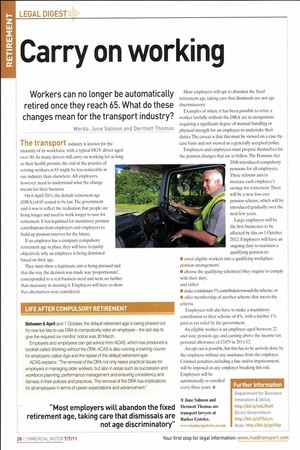Carry on working
Page 28

If you've noticed an error in this article please click here to report it so we can fix it.
Workers can no longer be automatically retired once they reach 65. What do these changes mean for the transport industry?
Words: June Salmon and Dermott Thomas
The transport industry is known for the maturity of its workforce, with a typical HGV driver aged over 50. As many drivers will carry on working for as long as their health permits, the end of the practice of retiring workers at 65 might be less noticeable in our industry than elsewhere. All employers, however, need to understand what the change means for their business.
On 6 April 2011, the default retirement age (DRA) of 65 ceased to be law. The government said it was to reflect the realisation that people are living longer and need to work longer to save for retirement. It has legislated for mandatory pension contributions from employers and employees to build up pension reserves for the future.
If an employer has a company compulsory retirement age in place, they will have to justify objectively why an employee is being dismissed based on their age.
They must show a legitimate aim is being pursued and that the way the decision was made was 'proportionate; corresponded to a real business need and went no further than necessary in meeting it. Employers will have to show that alternatives were considered. Most employers will opt to abandon the fixed retirement age, taking care that dismissals are not age discriminatory.
Examples of where it has been possible to retire a worker lawfully without the DRA are in occupations requiring a significant degree of manual handling or physical strength for an employee to undertake their duties.The caveat is that this must be viewed on a case-bycase basis and not viewed as a generally accepted policy.
Employers and employees must prepare themselves for the pension changes that are to follow. The Pensions Act 2008 introduced compulsory pensions for all employees. These reforms aim to increase each employee's savings for retirement. There will be a new, low-cost pension scheme, which will be introduced gradually over the next few years.
Large employers will be the first businesses to be affected by this on 1 October 2012. Employers will have an ongoing duty to maintain a qualifying pension to: • enrol eligible workers into a qualifying workplace pension arrangement; • choose the qualifying scheme(s) they require to comply with their duty; and either: • make a minimum 3% contribution towards the scheme; or • offer membership of another scheme that meets the criteria.
Employees will also have to make a mandatory contribution to their scheme of 4%, with a further 1% paid as tax relief by the government.
An eligible worker is an employee aged between 22 and state pension age, and earning above the income tax personal allowance of 0,475 in 2011/12.
An opt-out is possible, but this has to be actively done by the employee without any assistance from the employer. Criminal penalties, including a fine and/or imprisonment, will be imposed on any employer breaking this rule. Employees will be automatically re-enrolled every three years. • • June Salmon and Dermott Thomas are transport lawyers at Barker Gotelee.
n%v %s.harkergotelee.co.uk








































































































































